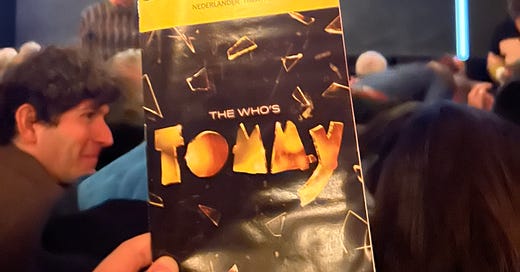The Who’s “Tommy” is Nostalgic, Stylized Sensory Overload
To put it lightly, watching this musical is definitely an "experience."
I walked out of The Who’s “Tommy” in a fog, almost like I’d been drugged. I had an overwhelming feeling that I’d just “experienced” something (in the strongest sense of the word) and had a slightly disturbed aftertaste.
That dazed, overwhelmed, and even confused state partly comes from the plot of the show, to which I ironically went in blind. Based on a concept album written by Pete Townshend, “Tommy” tells the story of a boy named Tommy in post-World War II England. His father (Adam Jacobs) serves during the war, and his mother (Alison Luff), thinking her husband was gone for good, starts seeing another man. However, her husband does return home, and upon seeing his wife with a new man, shoots and kills the other man right in front of his wife and Tommy. Immediately, Tommy’s parents panic and tell Tommy he didn’t see or hear a thing — only then to realize their child has gone “deaf, dumb, and blind.”
This is all within the first 15 minutes of the show.
Four-year-old Tommy (Olive Ross-Kline and Cecilia Ann Popp) then becomes the subject of disturbing study and neglect. His parents take him to psychiatric testing, where the little actress playing Tommy got so spun around on tables and cast members that I thought she’d puke. Tommy is bullied by his family and friends and assaulted by his uncle. Through it all, he remains blank; the children playing Tommy at age four and ten are like props rather than person. It is haunting, chilling.
The glimpse of hope doesn’t come when the parents try religion, or even seeking out an Acid Queen (Christina Sajous), but rather when Tommy starts playing pinball. He’s not only good — he’s a wizard. It’s this feat that alerts everyone else that Tommy is really conscious, alert, and awake somewhere inside.
And this is all in just Act I.
The plot of “Tommy” seems to work best when you try to ignore the chaotic fever dream elements and just play along. That’s why the design of this production works so well— it’s a highly stylized, controlled version of that chaos. It was the most impressive lighting (Amanda Zieve) and set design (David Korins) I’ve seen all season, moving us quickly to various elements of Tommy’s word: the war before he was born, complete with parachuting soldiers; a simple English home; the scariness of a psychiatric ward; a schoolyard; the future.
There are projections (Peter Nigrini) that create realistic backgrounds against more abstract sets and magical lighting choices to shift our focus and imagine people are really flying or dying. It’s not messy; it’s incredibly precise. The moments from one plot point to another are lightning fast and calculated. I never felt like a transition was unnecessary or clunky.
These effective beats and pacing are particularly impressive because the show is almost entirely sung through. The choreography (Lorin Latarro) helps keep everything cohesive and moving; even when most of the ensemble is on stage, they move synchronously so that they’re both a feat to watch and still not distracting from whatever’s supposed to be our main focus.
Yet that focus tends to be a production element rather than an actor. The older Tommy (Ali Louis Bourzgui), who also comes in early in the show to sing to younger versions of himself, has a beautifully deep voice, but it often feels second to what’s going on around him. Because the action is so amplified by the chaos of the plot and production, the cohesion in design means no one actor truly stands out, even if they’re all giving impressive performances.
“Tommy” therefore feels more like an “experience” rather than a musical. We don’t engage with it as much as have it projected onto us. But is that necessarily a bad thing?
It depends on who you ask. As someone who went into the show knowing very little, the experience was engaging but also disturbing, almost enjoyable. For the dedicated fans — like the woman in the front row who stood up, started singing, and waved her phone with a flashlight during the last number — it’s a collective, powerful community experience.
Thanks for reading! “Tommy” is on Broadway and currently selling tickets through the end of the year.
How I found out about it: This is a show I knew very little about because I was clearly not the intended audience. I saw very little about it on my social feeds, which is more unusual for a Broadway show. I had seen it on Theater Development Fund (TDF) a few times.
Why I went/How I got tickets: My kind Aunt Sarah and Uncle Andy! They’d seen the show before but couldn’t make this date. I can’t pass a free ticket to a Broadway show!
How you can get tickets: As mentioned above, “Tommy” is on TDF quite often. You can also enter the lottery on Broadway Direct.






Convinced by this